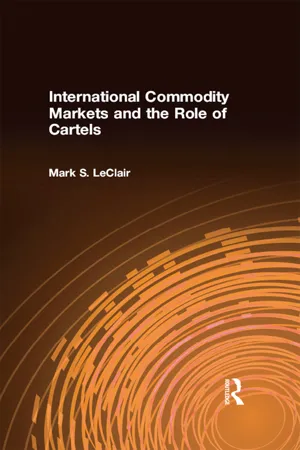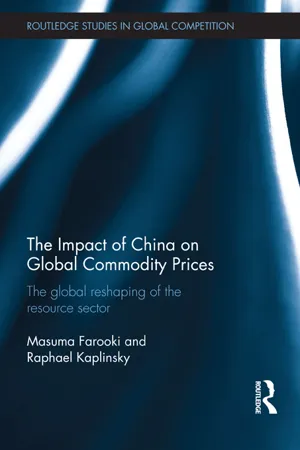Commodity Dependence
Commodity dependence refers to a situation where a country's economy heavily relies on the export of a single or a few primary commodities, such as oil, minerals, or agricultural products. This reliance can make the country vulnerable to fluctuations in global commodity prices, leading to economic instability and limited diversification. Diversifying the economy and reducing dependency on a single commodity is often a key policy goal for such countries.
4 Key excerpts on "Commodity Dependence"
- Mark S. LeClair(Author)
- 2016(Publication Date)
- Routledge(Publisher)
...2 The Dependence of Developing Nations on Commodity Exports As discussed in chapter 1, production of most key commodities is centered in the developing world. In many cases, the exported goods constitute a significant proportion of the country’s foreign earnings, and therefore price variability in commodity markets can result in severe economic stress. As commodity prices slide, the funds needed to procure the imports critical for development decrease. The result is falling growth rates, the inability to repay international financial obligations, and potential political instability. This chapter will consider the relative dependency of developing nations on single-versus multiple-export trading. The numbers show that the impact of price instability is most severe for single-commodity exporters. Thus Ghana, which relies almost entirely on cocoa to secure foreign exchange, is far more vulnerable to price swings than a diversified exporter like Brazil. Although prices of primary commodities have tended to move in tandem, rising in the 1970s and falling together in the 1980s, this price correlation is not absolute. It is unlikely, for example, that the international markets for cocoa, coffee, sugar, and tin—all significant exports of Brazil—will simultaneously see a decline in prices. It appears that a broadly diversified export mix spreads out the risk of falling prices. By estimating the impact that declining commodity prices have exerted on export earnings during the last two decades, it becomes clear that even modest changes in a nation’s product mix can result in significant economic benefits. The chapter concludes with an examination of UNCTAD, the first global commission to aggressively support the formation of “cooperative” cartels (i.e., those that incorporate both producing and consuming nations)...
- eBook - ePub
The Impact of China on Global Commodity Prices
The Global Reshaping of the Resource Sector
- Masuma Farooki, Raphael Kaplinsky(Authors)
- 2013(Publication Date)
- Routledge(Publisher)
...This change, as we will see in Chapter 4, has arisen as a direct consequence of the sustained and rapid growth of the Chinese economy, which we reviewed in Chapter 1. What is a commodity? Commodities are key for all economies. For commodity-producing economies, the commodities sector is central to the generation of incomes and the provision of livelihoods. For commodity-using economies, commodities are a critical input into production. For all countries, commodities help to satisfy the basic consumption needs of citizenry. Moreover, the production and use of commodities have large environmental impacts, often spilling over from one neighbourhood and one country to another. What happens in the commodities sector is thus of critical concern to all of humankind. As we shall see below, the global commodities sector is of considerable size. But it is a heterogeneous sector, made up of a variety of distinct products, involving very different production processes. Consequently, it is associated with markedly different patterns of social organisation, covering the spectrum from very small-scale, labour-intensive and low-technology units to gigantic, capital-intensive and high-technology production. Thus the exploitation of commodities has complex impacts not just on economic inputs and outputs, but also on the social and political systems that are associated with their production. We can think of ‘commodities’ in a variety of related ways. For most people the word conjures up a physical image – an agricultural product such as tea, coffee or cocoa; perhaps an ore mined from under the earth such as copper or iron and used in other industries; precious stones such as diamonds, used for adornment and as an investment; and oil and gas which are used as an industrial input and in personal consumption. But in recent years the word “commodity” has come to assume another meaning, relating not to its physical quality, but to its nature as an exchangeable product...
- eBook - ePub
- Javier A. Reyes, W. Charles Sawyer(Authors)
- 2019(Publication Date)
- Routledge(Publisher)
...However, the development of manufacturing may require a substantial investment in the country’s infrastructure. Revenues from the production of commodities may allow the country to finance this more easily than a country without such resources. The result is that the country may be able to grow faster. Second, the development of infrastructure may require imports, such as capital equipment, from developed countries. In turn, these imports will require foreign exchange. The export of a commodity can allow the country to more easily afford these types of imports. This should be a familiar story from the Golden Age of Latin American economic history. Third, a country with commodities may find it easier to transition into manufacturing than a country without such resources. Many commodities are the start of the process of producing a final good. For example, sugar can be refined into a product that is sold to consumers essentially as is. It can also be used to produce more sophisticated products such as candy or rum. The obvious first step in this process for a country with commodities is to add value to the primary product. As a result, countries with commodities may be able to make the transition to manufacturing more easily than countries without commodities. In practice, the scenario outlined above has been fraught with difficulties. In fact, these difficulties are so common in Latin America and elsewhere that they are sometimes referred to as the resource curse. Since Latin America is a large and heterogeneous region, not all of these problems apply to all countries. However, elements of the resource curse are, to a greater or lesser extent, part of the economic story of Latin America. 8 For example, the initial colonization of the region shows the resource curse in an extreme form. The initial motivating factor for Spanish settlement of the region was the extraction of gold and silver for shipment back to Spain...
- eBook - ePub
The Global Environment
Institutions, Law, and Policy
- Regina S. Axelrod, Stacy D. VanDeveer(Authors)
- 2019(Publication Date)
- CQ Press(Publisher)
...The same is true of people who work to extract minerals and fossil fuels from the earth. A reasonable estimate is that nearly 150 million nonretail production workers and nearly 500 million households depend on production of these commodities, and millions more are indirectly related to them. 56 These numbers do not include the additional millions dependent on the production of the thousands of categories of finished goods. Even if it were possible for higher-income societies and consumers to stop consuming these commodities, throwing hundreds of millions of families out of work and leaving them without any means of support would not beget sustainable development either. The commodity chains discussed here are complex webs of social relations connecting people and markets across great distances (geographic and otherwise). Thus citizens and governments in the South and the North share responsibility for the ecological and humanitarian effects of global markets. We are all consumers—although some of us consume a lot more than others—sharing a measure of responsibility for sustainable development in our own countries and around the world. The following list presents only a few sets of policy and governance options that could reduce aggregate material throughput in consumer societies or address specific aspects of the ecological and humanitarian damage engendered by today’s globalizing political economy. Most of these options can be deployed at multiple levels of government in the public sector, within the private or civil society sector, or through some combination of public, private, and NGO actors and institutions. They can be used by national and local governments, colleges and universities, and firms. Command-and-control regulations. With policies that reduce the generation of waste, increase recycling, engender cleaner product design, and encourage energy efficiency and renewable energy development, government mandates remain common and often prove effective...



